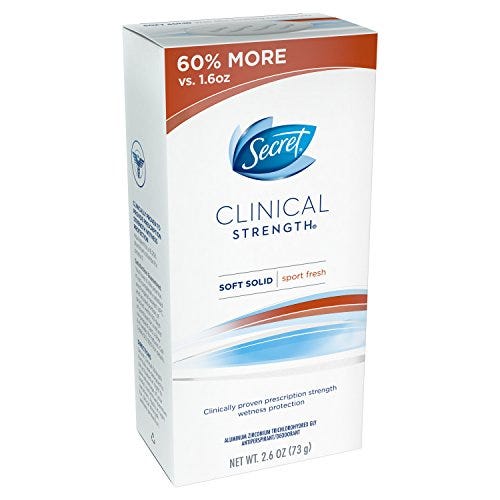When you’re killing your last set at the gym, a drenched tank or dripping top knot isn’t the worst thing in the world. But a big presentation? First date? Job interview? Yeah, not exactly when you’re looking for sweaty palms and pit stains.
Let’s break down everything you need to know about perspiration.
Why do I sweat?
As stinky as it might be sometimes, it’s important to remember that sweating itself is completely normal. Essential even. “We sweat to help regulate our body temperature,” says Debra Jaliman M.D., an assistant professor of dermatology at Icahn School of Medicine at Mount Sinai. “It allows our body to cool off through evaporation.” You see, your body is actually always sweating as a way of regulating your core temperature.
You only see those annoying beads of perspiration when the output exceeds the rate of evaporation—something that can be caused by a sunny day or mountain of stress. Feeling like you’re sweating buckets under these kinds of conditions is not uncommon and doesn’t usually point to a serious health problem.
So how much sweat is too much sweat?
There’s a wide range of what’s considered normal when it comes to perspiration: People can sweat less than a liter, or up to several liters per day, based on the demands their body is under. So if you’re a regular exerciser or work or live in hot and humid conditions, expect to regularly sweat a lot. That’s par for the course.
View this post on Instagram
Sweaty, messy jiu jitsu hair.. 😝💪🏻 #BJJ #bluebelt #nevergiveup 💙🥋
A post shared by Demi Lovato (@ddlovato) on
But while sweating is totally natural, there are occasions where your body sweats more than it needs to. Some 220 million people worldwide (about 3 percent of the population) suffer from excessive sweatiness, a.k.a. hyperhidrosis. The glands that are responsible for sweating are called apocrine glands, and in patients with hyperhidrosis, these sweat glands are overactive, producing much more sweat than is needed to cool the body.
The condition can be generalized (affecting the entire body) or localized to particular parts of the body. Generalized hyperhidrosis is often a symptom of an underlying health condition, including metabolic disorders (such as hyperthyroidism), diabetes, infections or lymphatic tumors. Excessive sweating can also result from alcohol abuse or withdrawal, or be brought on by certain medications, particularly antidepressants. Anxiety and changes in hormones have also been linked to generalized hyperhidrosis.
Localized hyperhidrosis, on the other hand, is not usually a symptom of separate conditions. Most people associate it with extra sweaty pits, but only 2 percent of your body’s sweat glands are actually located there. That means localized hyperhidrosis can also occur in the feet, hands, head, and other parts of the body.



Because people have different sweat needs, it can be hard to definitively say how much sweat it takes to be considered excessive. So how do you know if you have a serious problem? A doc can confirm the diagnosis, but you might have hyperhidrosis if you find yourself sweating through your clothing, getting skin problems from excessive wetness, or sweating even when you aren’t exerting yourself.
What can I do to sweat less?
If your sweat is causing you stress and embarrassment, start with an at-home plan of attack by upping the kind of antiperspirant you use. “Patients can start with ‘clinical strength’ antiperspirants such as Degree, Secret, or Mitchum,” suggests David E. Bank, M.D., a board-certified dermatologist, assistant clinical professor of dermatology at Columbia Presbyterian Medical Center, and author of Beautiful Skin: Every Woman’s Guide to Looking Her Best at Any Age.
“Specialized antiperspirants for excessive sweating such as Certain-Dri and prescription-strength Drysol have been on the market for years and are proven effective with regular use for many people with excessive sweating.” For best effectiveness, apply the product at night, suggests Jaliman. This gives the antiperspirant time to absorb into your skin and really begin to work.
Since 2004, Botox has been FDA-approved for treating severe sweating in both the underarms and palms, says Bank. Just as the famous face-freezer works to prevent those furrow lines from forming, Botox also temporarily blocks the release of the chemical that turns on your sweat glands. According to the International Hyperhidrosis Society, Botox injections have been shown to reduce sweating 82 to 87 percent. Patients see results, which typically last seven to 12 months, in just two to four days.
You don’t need to suffer in silence.
The most important thing to remember? It’s not “no big deal.” Experts say that excessive sweating can significantly impact a person’s quality of life, so it’s important to address any and all concerns you have around your level of sweat. Medications for diabetes and thyroid disease, as well as certain high blood pressure and antidepressant medicines, can trigger excessive sweating. Heavy sweating can also be caused by infections, certain cancers, heart or lung disease, menopause, and sometimes even a stroke.
The bottom line: If your sweat is causing a serious problem in your life, talk to your doc.
Source: Read Full Article

